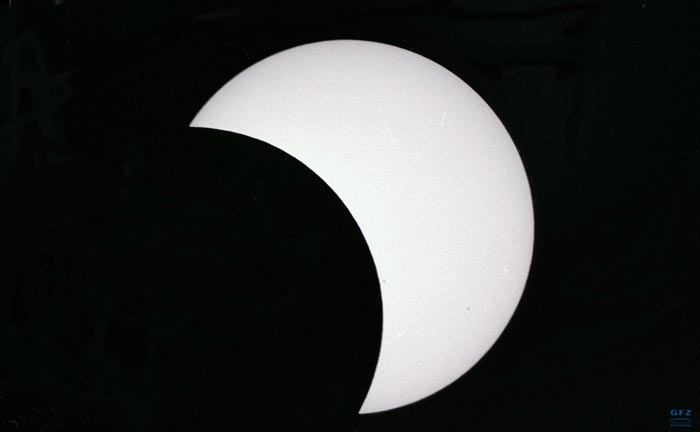Partial Eclipse of the Sun in Central Europe and a Solar Storm

Solar eclipse of 1999 (photo: L. Grunwaldt, GFZ)
A total eclipse will be visible further north for the residents of the Faeroe Islands and Svalbard. In northeastern Germany 75% of the sun will be covered by the moon.
In the area around Berlin and Potsdam this spectacular event will start at 9:38 am and the maximum eclipse will be reached at 10:47 am. The partial eclipse will finish at 11:58 am. The next partial eclipse in Central Europe will take place in the summer of 2021.
A team of researchers focusing on space weather, headed by Prof. Claudia Stolle at the GFZ German Research Centre for Geosciences, will investigate the effects of the eclipse in collaboration with Prof. Jorge Chau and colleagues at the Leibniz-Institute for atmospheric physics (Kühlungsborn).
To measure the effects of the eclipse on the upper atmosphere and space weather, observations by magnetometers in Niemegk, Iceland and Svalbard, by an Ionosonde in Juliusruh and a Medium-Frequency Radar (MF-Radar) will be used.
The upper atmosphere will most likely exhibit a lower degree of ionisation and a decline in electric currents as a result of reduced solar radiation. These effects are expected to be rather weak and will probably only be detected under quiet geomagnetic conditions. The current global geomagnetic activity is quantified by the Kp-Index, which is documented by GFZ www.gfz-potsdam.de/kp-index
Disturbing factor solar storm
Strong solar wind may disturb the observations. Since March 17, 2015, plasma originating from a coronal mass ejection at the surface of the sun impacts the geomagnetic field, which protects our planet.
This resulted in a geomagnetic storm, which was observed not only at geomagnetic observatories operated by GFZ, but also at other institutes worldwide. Data from the American satellite ACE (Advanced Composition Explorer) reported on unexpectedly high velocities of the solar plasma.
The strength of a geomagnetic storm is measured by the above mentioned Kp-index, on a scale from 0 to 9. The Kp-index is determined and distributed internationally by the GFZ German Research Centre for Geosciences.
The geomagnetic storm of March 17, 2015 is comparable in force to a hurricane on Earth, with Kp-values between 7 and 8 throughout 12 hours. The equatorial Dst storm index, which describes the geomagnetic activity at low latitudes, reached -221nT at 23UT, and indicated the peak of the storm on Earth. For comparison, during the most recent super storm (October 30, 2003) the peak value of the Dst was -383nT.
The strength of the storm is likely to diminish during the next days. However, solar flares may still hit Earth. If this is the case, the effect of the solar eclipse on Friday, March 20, 2015, will be hard to determine, as the associated geomagnetic storm will interfere with or superpose the geomagnetic signature of the partial eclipse.
Please, wear proper eye protection when observing the partial eclipse (eclipse eyeglasses)! Regular sunglasses or blackened glasses are not suitable.
Photos in a printable resolution may be found here:
Polar lights during the solar storm at the Søndrestrøm Incoherent Scatter Radar, Kangerlussuaq, Greenland, 17.03.2015 (Photos: Jürgen Matzka, GFZ)
https://media.gfz-potsdam.de/gfz/wv/05_Medien_Kommunikation/Bildarchiv/Sonnenfinsternis/Polarlicht_Groenland1.jpg
https://media.gfz-potsdam.de/gfz/wv/05_Medien_Kommunikation/Bildarchiv/Sonnenfinsternis/Polarlicht_Groenland2.jpg
Solar eclipse of 1999 (photo: L. Grunwaldt, GFZ):
https://media.gfz-potsdam.de/gfz/wv/05_Medien_Kommunikation/Bildarchiv/Sonnenfinsternis/Sofi_1999_02.jpg
Media Contact
All latest news from the category: Earth Sciences
Earth Sciences (also referred to as Geosciences), which deals with basic issues surrounding our planet, plays a vital role in the area of energy and raw materials supply.
Earth Sciences comprises subjects such as geology, geography, geological informatics, paleontology, mineralogy, petrography, crystallography, geophysics, geodesy, glaciology, cartography, photogrammetry, meteorology and seismology, early-warning systems, earthquake research and polar research.
Newest articles

Properties of new materials for microchips
… can now be measured well. Reseachers of Delft University of Technology demonstrated measuring performance properties of ultrathin silicon membranes. Making ever smaller and more powerful chips requires new ultrathin…

Floating solar’s potential
… to support sustainable development by addressing climate, water, and energy goals holistically. A new study published this week in Nature Energy raises the potential for floating solar photovoltaics (FPV)…

Skyrmions move at record speeds
… a step towards the computing of the future. An international research team led by scientists from the CNRS1 has discovered that the magnetic nanobubbles2 known as skyrmions can be…




















